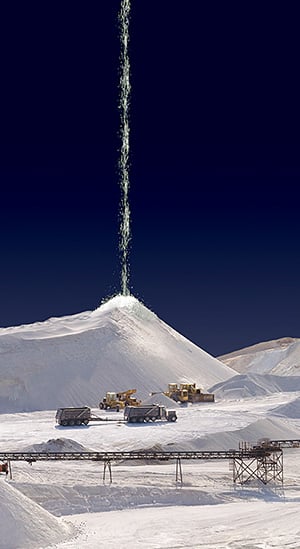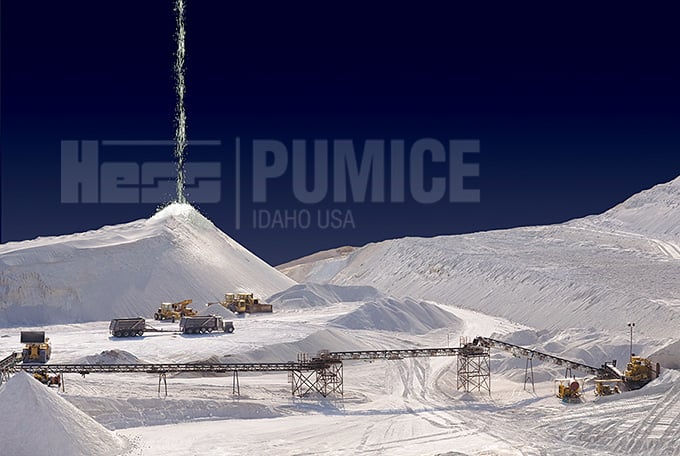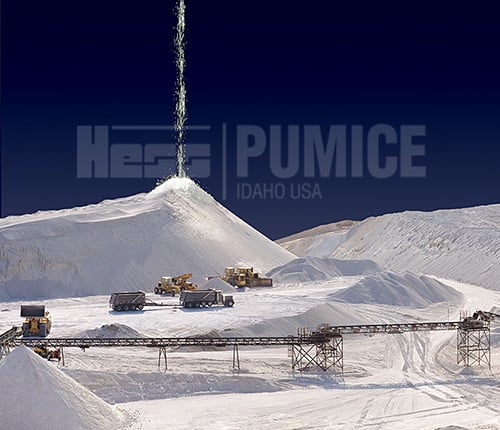BASE INFORMATION
Frequently Asked Questions About Our Pumice and Processes
A collection of question-and-answer content from the pages of our site.
[ ••• ]
ABSOLUTELY. FOR OVER 60 years, we’ve been mining, refining and supplying pumice products to industry from an exceptional deposit in Southeast Idaho, USA. We know our stuff. Pumice is so incredibly versatile , we know we haven’t yet seen it all, but we do have deep experience fitting pumice to a wide variety of industrial processes and consumer-direct uses. We also have the processing and blending processes to get you a perfect-fit grade, grade blend, or pumice-blended product. Contact Brian Jeppsen , VP of Research & Development, at 208-766-4777 x111 or rd@hesspumice.com
[ ••• ]
PUMICE IS USED WIDELY in industrial processes and consumer products. We’ve a comprehensive listing of pumice uses on the Uses for Pumice site page. Expanded content on many of those uses and applications is linked from that overview page.
[ ••• ]
WE PROCESS OVER 70 grades and grade-blends of pumice—from chunky mine-grade aggregates (for lightweight geotechnical fills and concrete mix designs) down to smoke-fine powders averaging 3 microns, (used as an ultra-pozz and as a functional filler). A table of our standard grades is available on the pumice grades and types site page. We also work with our customers to blend custom grades to meet the demands of a particular process or product.
[ ••• ]
IF WE DON’T CURRENTLY produce a grade (we produce over 70 standard and specialized grades) that meets your specifications, we will work with you to develop one. Contact Brian Jeppsen , VP of Research & Development, at 208-766-4777 x111 or rd@hesspumice.com He’ll make sure you get what you need, packaged to fit your requirements, shipped to wherever you need it, worldwide.
[ ••• ]
PRODUCTION TURNAROUND TIME for pallet-quantities of most grades is two (2) weeks from order to shipping-ready. We have stocking distributors that may be able get you product more quickly. Widely-used grades may be available from warehouse stock, depending on quantity needed. Small quantities (from just a couple of pounds in a pouch to as many as 3 production-sized bags) are available for direct-order from our Pumice Store site.
[ ••• ]
WE ARE HAPPY TO get you what you need. Contact Brian Jeppsen , VP of Research & Development, at 208-766-4777 x111 or rd@hesspumice.com to discuss your needs and request a sample.
[ ••• ]
YOU CAN ORDER PUMICE online from our Pumice Store for a variety of uses. Typically available in as little as a one-pound resealable pouch to a full-sized production bag (35 to 50 lbs. depending on grade; up to three bags). Find what you need either from the site’s grade-directory or from the application-specific directory.
[ ••• ]
HESS SHIPS PUMICE ANYWHERE via rail, truck, intermodal and overseas via ocean carrier in canisters as small as 2 grams to bulk rail cars holding 100 tons. We ship to any continent. Wherever you are, we’ll get it there.
We know your supply chain is crucial—that product must arrive on spec, on time, and packaged conveniently for end use. We’re serious about remaining the most sophisticated producer and supplier of pumice in the world market. And quite honestly, we’re very good at it. Learn more .
[ ••• ]
WE HAVE AN EXTENSIVE Downloads Library loaded with informational PDF files , including safety data sheets, technical data sheets, certifications and declarations , research summaries, and various use-specific knowledge briefs, whitepapers, info-graphics.
[ ••• ]
NO. Pumice is NOT CREATED EQUALLY by nature. The color, the hardness, the purity, the chemical composition—it all differs from deposit to deposit. Hess mines and processes a superior quality pumice —the world’s purest and whitest commercially available pumice.
Nor are the companies who supply pumice to industry equal in their ability to refine pumice to any needed grade and do so consistently. Hess processes pumice in three state-of-the-art plants sourced from a superior pumice deposit that is in demand around the world. Hess also has the ability to blend pumice-content products—for example: lightweight mortars and stuccos , lime-pozzolan (PHL) plasters, well cements, cementitious injection grouts .
[ ••• ]
WE EMPLOY SPECIALIZED impurity extraction technologies which make it possible to achieve an extremely high purity content for our pumice—98%-99.8%, depending on grade. A large percentage of our pumice products are shipped to markets outside of North America due to advantages in purity and color. But it all starts with the natural purity of our pumice deposit—washed clean of heavy metals and other impurities by the relentless wave action of an ancient inland sea.
[ ••• ]
BEING CHEMICALLY INERT and crystalline silica-free (because of its amorphous structure), Hess Pumice is both safe to use (OSHA-classified as no more than a nuisance dust) and safe for the environment. The success of our NCS grades as functional fillers in the paint and coatings industry begins with its use as a safe alternative to crystalline silica fillers and ends with its performance.
[ ••• ]
PUMICE IS AN AMORPHOUS aluminum silicate originating as volcanic ash. We’ve dedicated a site page to detailing this answer: The Story of Pumice . In short: Pumice is a light, foamed volcanic glass stone—formed of silky, interlocking fibers filled with tiny air bubbles, the surface (at any grade) riven with nooks and crannies and covered with biting edges. It is that frothy matrix of vesicles that give pumice its unique and infinitely useful qualities. Pumice has no crystalline structure, is naturally calcined, and is abundant, economical, and sustainable.
It is also important to note that pumice is not scoria. Scoria is that typical lava rock sold as mulch or for fire pits, darker in color, formed from gases trapped within a viscous lava flow. Pumice is the result of explosive eruption of foamy molten magma, and is lighter both in color and form factor (low density, small vesicles with thin walls).
[ ••• ]
IN CERTAIN INDUSTRIAL applications, it certainly does. Take, for instance, the decorative concrete industry. Pumice is used as both a lightweight aggregate and a concrete performance super-charging pozzolan . But it’s the whiteness of Hess pumice—scoring a GE brightness of 84—that seals the deal: as the final whiteness of the concrete product or the pureness of its dyed color is critical. Manufactured stone veneer products (pumice is used as a lightweight aggregate) and Glass Fiber Reinforced Concrete (GFRC) structure cladding panels (pumice pozzolan adds strength and density) are two examples of such products. Or take the paint industry, which uses microfine pumice as a functional filler . Color matters in that application as well.
[ ••• ]
ANCIENTLY, YES. Pozzolan, or as the Romans called it, pozzolana , is a finely ground pumice, which, when mixed with their hydrated lime cement, resulted in an incredibly durable concrete. Today, there are other concrete additives used as “pozzolans,” including fly ash (a byproduct of the coal-fired power industry), silica fume (byproduct of producing silicon metal or ferrosilicon alloys), metakaolin (a calcined kaolin clay), and others. But pumice is the original, highly effective natural pozzolan. Hess UltraPozz was chosen over all other pozzolan products/types by the U.S. Department of Energy and Canadian Atomic Energy Commission scientists in developing the ultrafine cementitious injection grout needed to seal microfractures in the confinement caverns deep underground at the DOE’s Waste Isolation Pilot Plant in New Mexico.
[ ••• ]
NO. The largest available is mine-grade aggregate averaging one inch.
[ ••• ]
Hess Pumice sells (via an online store) several consumer-direct brands that match the ideal pumice grade(s) to the end-use application—horticultural potting soil amendments and soilless grow medias, polishing grits, cleaning grits, mix-in cosmetic exfoliants, critter bathing dust (chinchillas, degus, poultry), more.
[ ••• ]
Absolutely. We’ve put up a comprehensive website (canoesofconcrete.com ) with full information, resources, recommended grades, and aggregate order links for testing samples and production material.
Additional Question and Answer-style content available at aboutpumice.com



I’m thinking pumice. Can you help me determine if pumice would work for my particular needs? [ ••• ]
What are the processes and product types currently using pumice? [ ••• ]
What grades of pumice powders and aggregate do you supply? [ ••• ]
Sure, Hess refines a lot of standard pumice grades, but what if I need something special? [ ••• ]
How soon can I get my pumice? [ ••• ]
I’d like to run some tests at my lab. Can I get samples? [ ••• ]
How and where can I buy small amounts of pumice for personal use? [ ••• ]
What are my shipping options? [ ••• ]
Where can I find product data sheets, safety information, research, and other official documents? [ ••• ]
Pumice is pumice, right? It’s basically all the same. [ ••• ]
What about the purity of the Hess pumice? [ ••• ]
Is pumice safe to work with? [ ••• ]
So...what is pumice, specifically? [ ••• ]
Does pumice color matter? [ ••• ]
“Pumice” and “Pozzolan”...the same thing? [ ••• ]
Do you supply large pumice stones? [ ••• ]
Where can I find specialized pumice products (for a variety of uses) that are sold consumer-direct? [ ••• ]
Does pumice work for competition concrete canoes? [ ••• ]